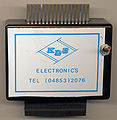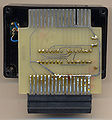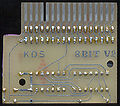Difference between revisions of "KDS 8-Bit Printer Port"
(→Versions) |
|||
| (30 intermediate revisions by 5 users not shown) | |||
| Line 1: | Line 1: | ||
| − | [[8bit Printer Ports|8bit printer port]] by [[KDS]]. Connects to the regular 34pin 7bit [[Connector:Printer port|Printer Port Connector]], and does somehow expand it to 8bit | + | == About == |
| + | [[8bit Printer Ports|8bit printer port]] by [[KDS]]. Connects to the regular 34pin 7bit [[Connector:Printer port|Printer Port Connector]], and does somehow expand it to 8bit. Contrary to other 8-bit printer port expansions, as long as the KDS v2 software driver is not loaded the CPC works in 7-bit mode as though the KDS v2 interface is not there. | ||
| + | |||
| + | The exact I/O mechanism used by KDS is unknown. All that we know is that it splits the port &EFxx into fragments. | ||
== Versions == | == Versions == | ||
| − | There are | + | There are two versions: |
| − | + | * The first one requires a power supply input and has a switch on top. It does not provide compatibility with CP/M. | |
| + | * The later one does not require a power supply input and does not have a switch. Compatibility with CP/M is provided. | ||
The original version was first advertised in April 1985, these adverts didn't mention whether or not it requires a power supply input (normally, its data latch should need a power supply). | The original version was first advertised in April 1985, these adverts didn't mention whether or not it requires a power supply input (normally, its data latch should need a power supply). | ||
| − | A year later, in April 1986 newer adverts included a note that power input isn't required, which may refer to a new version, and which may mis-use the signal levels as supply voltages - if so, it may require some programming cautions (such like not to switch all signals to LOW level for longer periods), accordingly it may be incompatible with software from the older version. | + | A year later, in April 1986 newer adverts included a note that a power input isn't required, which may refer to a new version, and which may mis-use the signal levels as supply voltages - if so, it may require some programming cautions (such like not to switch all signals to LOW level for longer periods), accordingly it may be incompatible with software from the older version. |
| − | Below are two photos, one showing a power-supply | + | Below are two photos, one showing a power-supply cable, one not showing one. Both have 34pin connectors, so both are probably printer-port-related hardware (although the photo with power cable is claimed to show a [[KDS Electronics Serial Interface|KDS Serial Interface]] with 50pin connector, which is obviously nonsense). |
| − | <gallery> | + | <gallery caption="KDS 8Bit Printer Port v1"> |
| − | Image:KDS.jpg| | + | Image:KDS.jpg|Interface Box |
| − | Image: | + | Image:KDS_8Bit_PrinterPort_Top.jpg|Interface Top |
| + | Image:KDS_8Bit_PrinterPort_PCB_Top.jpg|PCB Top | ||
| + | Image:KDS_8Bit_PrinterPort_PCB_Bottom.jpg|PCB Bottom | ||
</gallery> | </gallery> | ||
| − | == | + | <gallery caption="KDS 8Bit Printer Port v2"> |
| + | Image:KDS_8Bit_Printer_Port_v2_PCB_Top.jpg|PCB Top | ||
| + | Image:KDS_8Bit_Printer_Port_v2_PCB_Bottom.jpg|PCB Bottom | ||
| + | </gallery> | ||
| + | |||
| + | == Review and Ads == | ||
<gallery> | <gallery> | ||
| + | File:KDS 8bit printer port review.jpeg|KDS v2 Review | ||
| + | File:KDS printer port ads.jpg|KDS v2 Ad | ||
File:Amstrad Computer User8504_054.jpg|ACU Apr 1985 | File:Amstrad Computer User8504_054.jpg|ACU Apr 1985 | ||
| − | |||
File:ACU8605-048.jpg|ACU May 1986 | File:ACU8605-048.jpg|ACU May 1986 | ||
</gallery> | </gallery> | ||
| − | [[Category: | + | == Manual == |
| + | * [[Media:KDS_8Bit_Printer_Port_v2_Manual.pdf|KDS 8 Bit Printer Port v2 Manual]] (pdf) | ||
| + | |||
| + | [[Category:Printers and printer ports]][[Category:Peripherals]][[Category:Manual]] | ||
Latest revision as of 07:58, 7 July 2024
Contents
About
8bit printer port by KDS. Connects to the regular 34pin 7bit Printer Port Connector, and does somehow expand it to 8bit. Contrary to other 8-bit printer port expansions, as long as the KDS v2 software driver is not loaded the CPC works in 7-bit mode as though the KDS v2 interface is not there.
The exact I/O mechanism used by KDS is unknown. All that we know is that it splits the port &EFxx into fragments.
Versions
There are two versions:
- The first one requires a power supply input and has a switch on top. It does not provide compatibility with CP/M.
- The later one does not require a power supply input and does not have a switch. Compatibility with CP/M is provided.
The original version was first advertised in April 1985, these adverts didn't mention whether or not it requires a power supply input (normally, its data latch should need a power supply).
A year later, in April 1986 newer adverts included a note that a power input isn't required, which may refer to a new version, and which may mis-use the signal levels as supply voltages - if so, it may require some programming cautions (such like not to switch all signals to LOW level for longer periods), accordingly it may be incompatible with software from the older version.
Below are two photos, one showing a power-supply cable, one not showing one. Both have 34pin connectors, so both are probably printer-port-related hardware (although the photo with power cable is claimed to show a KDS Serial Interface with 50pin connector, which is obviously nonsense).
- KDS 8Bit Printer Port v1
- KDS 8Bit Printer Port v2









